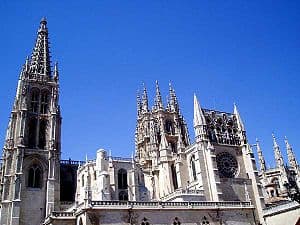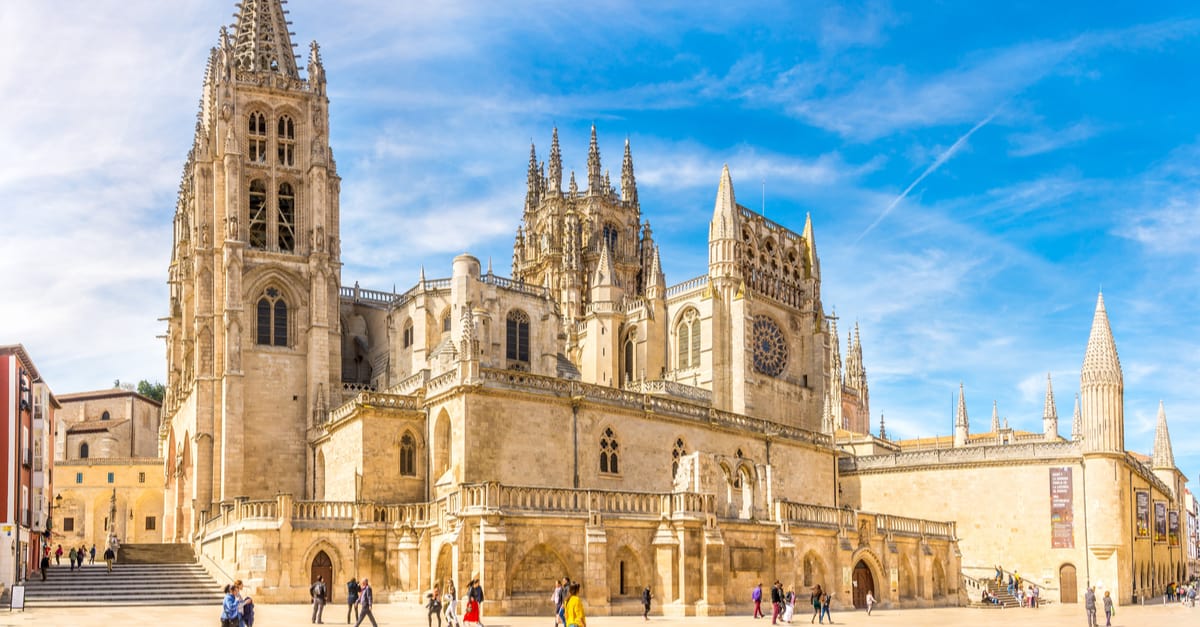I walked from San Juan de Ortega to Burgos,(23km). The last 10km walking into Burgos is along a four lane highway which is the main road through the industrial area. It is horrible, many pilgrims get the bus at the beginning of this stretch. I didn’t but the by time I was in the city I wished I had. Burgos is a beautiful city and worth spending a day there, there is a lot to see, but the industrial area…hell really, no shade, noise, walking on pavement.

The center is compact, and well preserved, with streets and squares lined by the familiar glazed balconies. Most of the interesting part is concentrated north of the river, which in summer meanders gently between green banks; those banks are flanked by high stone embankments, but the flood marks on the town hall bear witness to the fact that even these defenses fold before the water which sometimes comes down from the mountains to the east and north-east. If you’re visiting by car rather than staying in the town, make for the cathedral — there’s supervised parking in the plaza in front, and you’re right at the center of things.
What to see
Cathedral Gothic – cathedrals are not common in Spain, and distinctly rare in Northern Spain, so this one doesn’t have much competition; but it is, in any case, an exceptional building — in size outranked only by the cathedrals of Seville and Toledo, and in style representing a magnificent blend of the French Flamboyant Gothic with more characteristically Spanish elements. The basis of the church was built in the 13th century, but the splendid spires of the west front date from a second surge of building in the 15th century, as does the equally extravagant Capilla del Condestable behind the altar. The cathedral is full of interest, from the grand central lantern above the transept crossing to the tomb of El Cid directly beneath it. Unusual features include the majestic Escalera Dorada, a double staircase leading up to the north door, and the 16th-century Pampamoscas (fly-catcher) clock, with a grotesque, brightly painted human figure which opens its mouth on the striking of the hour. Because the cathedral is built on a hillside, you can get a good close-up view of its intricate exterior stonework by walking around on its north side.
Arco de Santa Maria – Just south of the cathedral, this is a vestige of the city’s fortifications, facing the river bridge of the same name. Although the arch dates from the 11th century, the statuary in which it is now clothed is of 16th-century origin.
Casa del Cordon – A couple of hundred yards east of the cathedral, across the pleasant oval space of the Plaza Jose Antonio, is this historic palace — so named because of the Franciscan cord embellishment on the façade. It was here that Ferdinand and Isabella (los Reyes Catolicos) received Columbus on returning from his second trip to America.
San Nicolas – This church, close to the west front of the cathedral, has a remarkable altarpiece that was carved at the beginning of the 16th century and contains all sorts of interesting scenes.
Casa de Miranda This fine mansion now houses the local archaeological museum, which contains several objects of more than local interest.
Nearby
Cartuja de Miraflores – A short drive east on the south side of the river brings you through woods to this 15th-century monastery. Its church was completed by Isabella the Catholic, and its centerpiece is an elaborate memorial to her parents, Juan II and Isabel of Portugal, with carvings of astonishing intricacy.
Monasterio de las Huelgas – This Cistercian nunnery just west of the center was based on a royal rural retreat (huelga means ‘rest’) and admitted only the very best young ladies. It became a place of enormous power in the 13th and 14th centuries — Edward I was knighted here, as well as many Castilian kings — and now offers interesting guided tours of grand rooms in various styles, including Arabic Mujedar decoration. There is a fine Romanesque cloister and the chapterhouse, draped with historic flags and tent-flaps, has interesting columns made up of several separate stone shafts. The great novelty of the church is a pivoted pulpit, designed to allow the preacher to lecture either the nuns or the public. There is a famous and unique collection of medieval textiles and other finds from royal tombs.
Where to stay
Landa Palace – The Landa Palace is, without doubt, the best hotel in town, except that it isn’t in town at all — it’s a couple of miles south. That in itself is a drawback since Burgos (more than most cities) is a place you’re likely to want to stay in rather than near; what’s more, the setting is unappealing — on high ground, exposed but without remarkable views, and close to the busy Madrid highway. But there are compensations: the hotel is based on a squat, solid tower dating from the 14th century which now accommodates the grand entrance hall and above that the King of Spain’s suite; the rest of the hotel is architecturally more ordinary, but the whole is superbly furnished in grand style, and the atmosphere is at once welcoming but dignified. There is a splendid indoor swimming pool and another pool in the garden.
Alternatives In the city, the most distinctive hotel is the Meson del Cid in a slightly elevated spot right opposite the west front of the cathedral; it is traditional in style, and spick-and-span throughout. The Meson del Cid faces competition from two conventional upmarket city center hotels, both of them housed in modern (but not very modern) buildings of no great distinction. The better buy is the Condestable, just to the east of the central area — it is spacious and comfortable, with a traditional-style restaurant and bar, and a stylish cafeteria.
Simpler and less spacious hotels offer some savings. The Fernan Gonzalez is neat and quite comfortable, with a mix of modern and traditional styles; it is south of the river, but still quite central. The Corona de Castilla further south costs much the same and is less appealing. The Cordon is a refreshing change — coolly stylish decor in an old townhouse close to the center.

I love hiking, backpacking, and camping. From the Camino de Santiago to the West Highland Way in Scotland or simply a great day hike on the weekend. Hiking refreshes me, my mind, and keeps my body reasonably fit. So far I have walked three Camino routes and many other long distance hikes in the UK, Canada, and around the rest of Europe. One of the best was my hike up Ben Nevis.

